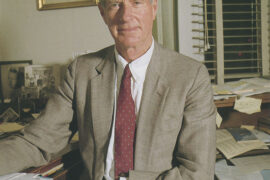Hundreds of men have found recovery and hope at Recovery Point of Huntington.
By Katherine Pyles
HQ 96 | WINTER 2017
They say you can’t choose your family. In some ways, then, it’s fitting that the 100-plus men of Recovery Point of Huntington refer to each other as “brothers.” None of them would have chosen the path of addiction that led them to West Virginia’s largest peer recovery center. Had they met anywhere else, few of them would have even become friends. But just like family, their bond today runs deep.
“We’re closer to each other than we are to our own blood brothers,” Recovery Point graduate Andrew Stanley says. “There’s just a deep, genuine love for each person here.”
Recovery Point was founded in 2011 as The Healing Place of Huntington, modeled after a similar program in Louisville that believes the best path to recovery is one addict reaching back to help another. Since then, more than 200 men have graduated from Recovery Point of Huntington. Now with locations in Charleston, Bluefield and Parkersburg, as well as a 92-bed women’s facility that opened in Charleston Nov. 5, the “been there, done that” model of recovery is saving lives throughout the state.
One of Recovery Point’s earliest graduates, Matt Boggs, is now its executive director.
“We in recovery know that there’s a way out because we’ve been there,” Boggs says. “There’s a dynamic of mutual support. We’re not a self-help program; we’re a mutual-help program.”
Funded entirely by grants and private donations, Recovery Point’s operational costs are $25 per person per day. The residents themselves don’t pay a dime. Boggs says small donations make a big difference. He knows, because he’s been there.
“A gift of $25 gives an individual in our program one day,” Boggs says, “and that one day could be the pinnacle for change.”
When a client enters Recovery Point, usually after months on a long waiting list, he begins nonmedical detox – a sometimes painful, terrifying process. For certain types of drug and alcohol use, clients have to be medically cleared to enter to ensure their safety and well-being. While in detox, newcomers are visited frequently by residents further along in their recovery who offer their own stories as inspiration and encouragement.
“A gentleman named Scott Hudson came to my bedside and asked if he could pray with me,” Boggs says of his own experience four years ago. “At that point I wasn’t ready for someone to pray with me, but I said OK. He prayed for me, and he told me about how bad he felt when he came in. But then he told me he gets to see his children again. His mom talks to him again. It gave me hope that maybe I could get there, too.”
The next phase is called Off The Street Phase I, where virtually every hour of the day is accounted for – no car, no cell phone, no leaving the property except for meetings. Every day, Off The Street residents walk 5 1/2 miles to attend classes and 12-step meetings.
“There’s a lot of accountability,” peer mentor Jeremy Halstead says. “Sometimes it feels like the whole city is watching us. We’re ‘those guys walking down 8th Avenue with backpacks on.’ ”
In Off The Street Phase II, additional freedoms bring additional responsibilities. Work assignments include the kitchen, the garden, maintenance, laundry, housekeeping and other jobs that keep the center up and running. Nothing teaches you more about recovery than a long day of hard work, Stanley says.
“It’s tough, but it’s also really awesome,” he says. “You start to realize that you can work 16 hours a day and still do the things you need to do for your recovery.”

In Recovery Phases I and II, residents are able to spend more time with their friends and family. When they graduate at the end of Recovery Phase II, they can either become a paid peer mentor or move into the transitional living house across the street and gain employment elsewhere. With every phase, the other residents decide whether someone is truly ready to take the next step.
“We on the leadership team are here to ensure the integrity of the model and the safety of the clients, but the guys run the facility,” Boggs says. “They’re building the brotherhood.”
Fellow residents also decide work assignments and even consequences for misconduct. If you can’t remember to make your bed, you might get put on housekeeping duty. If you can’t keep your clothes folded, laundry duty. If you’re a loner, there are jobs like “good-night patrol” and “high-five duty.”
“We get pretty creative,” Halstead laughs.
And it works. In Recovery Point’s five-year history, there’s never been a single physical fight.
“With the group conscience, nobody’s really an authority figure,” Halstead says. “You’re hearing the truth about yourself from somebody who loves you. It’s never about not making the bed – it’s about why you aren’t making the bed. And no one’s singling anyone out. We all have issues. We’re just trying to get to the bottom of what’s going on with each other.”
Boggs says the Recovery Point model is built on two simple principles: accountability and unconditional love.
“There’s therapeutic value in being honest, open and direct with your brothers,” he explains. “People in active substance use lose the ability not only to hold themselves accountable but also to hold others accountable. You ‘love each other to death’ by cosigning all those negative behaviors. But in recovery, you ‘love each other to life.’ Telling someone the truth, even when it hurts, is a form of love.”
Graduates of Recovery Point remain a part of the brotherhood, participating in “recovery checkups” and returning for classes and support when needed. Close to 70 percent of graduates remain abstinent for a year after graduation, a success rate five times higher than the national average, and around 55 percent of the 200-plus graduates remain compliant today – meaning they’re clean, employed and out of jail.
“Our graduates have a security net they can always fall back on,” Boggs says. “If they’re in a precarious situation, they can call us. If they relapse, they can come back. Even with the waiting list, they always have a place here. We’ll blow up a mattress and give them a spot on the floor.”
Like with any other chronic disease, he says, relapse is sometimes part of the journey. Halstead says his own relapse in 2015 would have killed him if it hadn’t been for the hope he knew he’d find if he returned to Recovery Point.
“Sometimes your willingness to do something has to come from rock bottom,” Halstead says. “For me, picking up again after being clean for two years was that bottom. It destroyed me. I hated myself. I lost everything I had worked for – my job, my apartment, my family. But I knew I had found happiness in here, and I knew I could have that again if I came back. It was the first time I really understood that this is a disease I will fight for the rest of my life. I realized I could either die with the disease or die from the disease.”
That realization hits home several times a day for the residents of Recovery Point. It hits home when they sit with someone going through detox, a reminder of their own difficult journey. It hits home when they answer the phone to a crying mother, begging for a bed for her son, a reminder of the hurt they’ve caused their own loved ones. It hits home when they see a friend’s obituary in the paper – “You almost become numb to it,” Halstead says. And it hits home when they do something as simple as sharing their story with another person in recovery.

“Our stories are different, but we all come from this place of not being able to find hope,” Stanley says. “There’s a common peril that binds us. When you share your story with someone, you realize how far you’ve come and you instill some hope in that person that life does get better.”
The Recovery Point brotherhood is well aware of the drug crisis facing our region. But there’s another epidemic worth talking about, Halstead says.
“Look at all the graduates who’ve come out of here,” he says. “Look at the new facilities that are opening up. Look at our waiting list – it’s the worst feeling in the world to be on that list, but that’s how many people want help. There’s so much recovery happening in Huntington, and it’s awesome. That’s the epidemic we should be talking about.”
If you’re feeling overwhelmed by Huntington’s drug problem, Boggs’ advice is simple: Come visit.
“I would encourage anyone who’s tired of seeing the news articles and hearing the statistics and seeing folks go to jail for substance use to come by our facility,” he says. “Just drop in. We’ll give you a tour. You can look around and see how our program operates. You can see the brotherhood and the smiles on these guys’ faces. I can promise it will do two things: It will reduce the stigma of what addiction looks like, and it would change your perception about recovery. You’ll see that addiction doesn’t have to be a life sentence. Recovery is possible.”
Partners in Recovery
Community partnerships not only keep Recovery Point running, but they also provide residents and graduates with a chance to invest in their community.
The Huntington community’s support for Recovery Point goes well beyond financial contributions, Boggs says.
Facing Hunger Food Bank provides food for the residents, and in return residents work at the food bank as volunteers. Fruth Pharmacy funds a scholarship for Recovery Point graduates seeking higher education or vocational training. Some of the men helped with the construction of Lily’s Place, a residential recovery center for drug-exposed newborns. Others helped with recent renovations at City Hall, a tangible investment in the community that has embraced them. Last summer, residents traveled to flood-ravaged areas of West Virginia to deliver supplies, and the Recovery Point garden produced so much food that they were able to donate some of it to the Huntington City Mission.
The community partnerships are too many to name, but one that’s especially fitting is a partnership with a new nonprofit called Gro Huntington, an urban garden and farm for individuals in recovery. In addition to tending the on-site garden at Recovery Point, men will soon be able to volunteer at the Gro Huntington farm.
“Gardening is so symbolic of recovery,” Boggs says. “You dig the bad soil out so that you can plant the seed and put good soil back in. You maintain it and watch it flourish and grow. Gardening isn’t just a therapeutic way to take ownership of the community. It’s an illustration of recovery.”
For information on how you can help, visit www.recoverypointwv.org or call 304.523.5673. Financial contributions are always needed, as are donations of household items.
“This is someone’s home for eight to 12 months,” Boggs says, “so anything you use at your house on a daily basis – shaving cream, a razor, soap, Kleenex, a toothbrush – is going to be helpful.”





